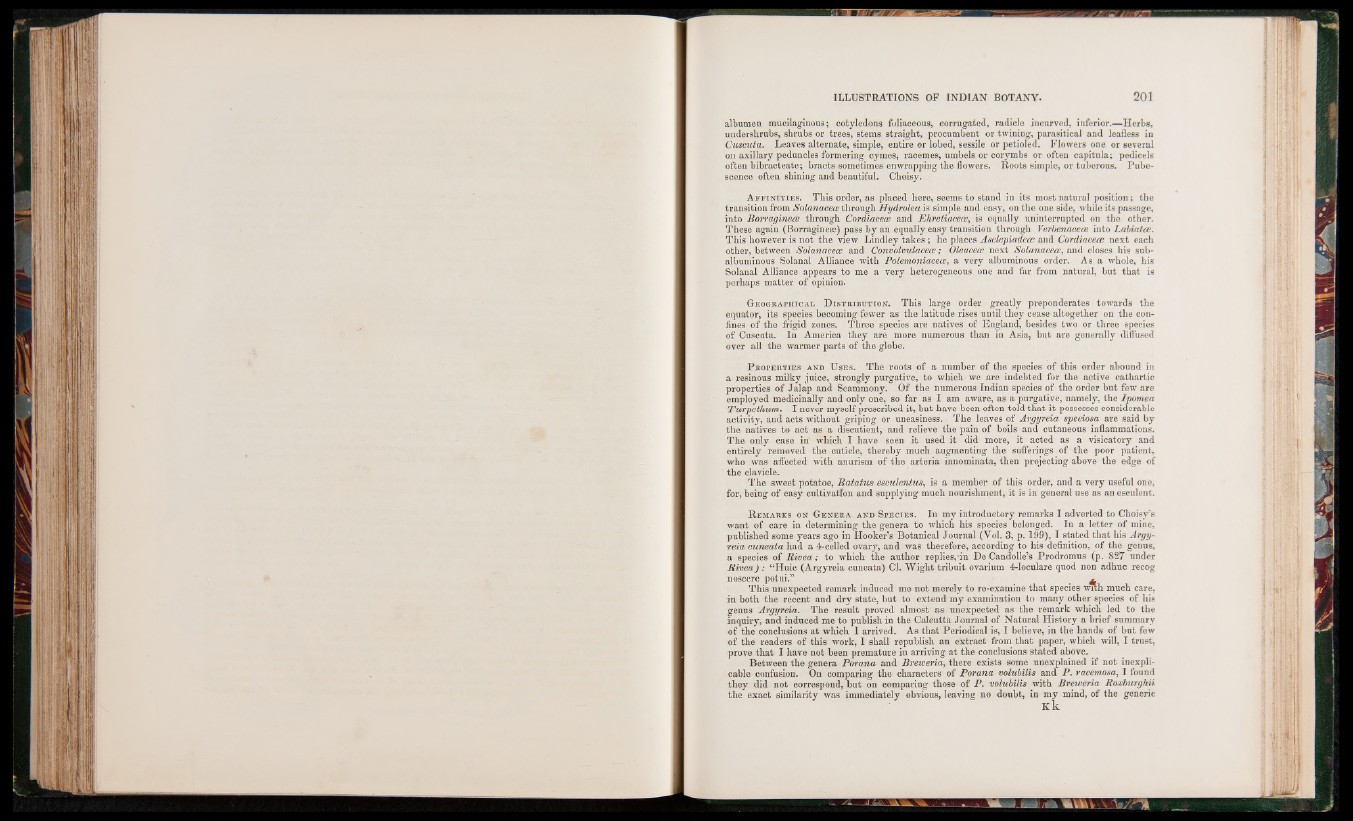
albumen mucilaginous; cotyledons foliaceous, corrugated, radicle incurved, inferior.—Herbs,
undershrubs, shrubs or trees, stems straight, procumbent or twining, parasitical and leafless in
Cuscuta. Leaves alternate, simple, entire or lobed, sessile or petioled. Flowers one or several
on axillary peduncles formering cymes, racemes, umbels or corymbs or often capitula; pedicels
often bibracteate; bracts sometimes enwrapping the flowers. Roots simple, or tuberous. Pubescence
often shining and beautiful. Choisy.
A f f in i t i e s . This order, as placed here, seems to stand in its most natural position; the
transition from Solanaceos through Hydrolea is simple and easy, on the one side, while its passage,
into Borraginece through Cordiacece and Ehretiacece, is equally uninterrupted on the other.
These again (Borragineae) pass by an equally easy transition through Verbenacece into Labiatce.
This however is not the view Lindley takes ; he places Asclepiadece and Cordiacece next each
other, between Solanacece and Convolvulacece; Oleacece next Solanacece, and closes his sub-
albuminous Solanal Alliance with Polemoniacece, a very albuminous order. As a whole, his
Solanal Alliance appears to me a very heterogeneous one and far from natural, but that is
perhaps matter of opinion.
G e o g r a p h ic a l D i s t r ib u t io n . This large order greatly preponderates towards the
equator, its species becoming fewer as the latitude rises until they cease altogether on the confines
of the frigid zones. Three species are natives of England, besides two or three species
of Cuscuta. In America they are more numerous than in Asia, but are generally diffused
over all the warmer parts of the globe.
P r o p e r t ie s a n d U s e s . The roots of a number of the species of this order abound in
a resinous milky juice, strongly purgative, to which we are indebted for the active cathartic
properties of Jalap and Scammony. Of the numerous Indian species of the order but few are
employed medicinally and only one, so far as I am aware, as a purgative, namely, the Ipomea
Turpethum. I never myself prescribed it, but have been often told that it possesses considerable
activity, and acts without griping or uneasiness. • The leaves of Argyreia speciosa are said by
the natives to act as a discutient, and relieve the pain of boils and cutaneous inflammations.
The only case in which I have seen it used it did more, it acted as a visicatory and
entirely removed the cuticle, thereby much augmenting the sufferings of the poor patient,
who was affected with anurism of the arteria innominata, then projecting above the edge of
the clavicle.
The sweet potatoe, Batatus esculentus, is a member of this order, and a very useful one,
for, being of easy cultivation and supplying much nourishment, it is in general use as an esculent.
R em a r k s on G e n e r a a n d S p e c ie s . In my introductory remarks I adverted to Choisy’s
want of care in determining the genera to which his species belonged. In a letter of mine,
published some years ago in Hooker’s Botanical Journal (Vol. 3, p. 199), I stated that his Argyreia
cuneata had a 4-celled ovary, and was therefore, according to his definition, of the genus,
a species of Rivea; to which the author replies,’in De Candolle’s Prodromus (p. 827 under
Rivea) : “Huic (Argyreia cuneata) Cl. Wight tribuit ovarium 4-loculare quod non adhuc recog
noscere potui.” ^
This unexpected remark induced me not merely to re-examine that species with much care,
in both the recent and dry state, but to extend my examination to many other species of his
genus Argyreia. The result proved almost as unexpected as the remark which led to the
inquiry, and induced me to publish in the Calcutta Journal of Natural History a brief summary
of the conclusions at which I arrived. As that Periodical is, I believe, in the hands of but few
of the readers of this work, I shall republish an extract from that paper, which will, I trust,
prove that I have not been premature in arriving at the conclusions stated above.
Between the genera Porana and Breweria, there exists some unexplained if not inexplicable
confusion. On comparing the characters of Porana volubilis and P. racemosa, I found
they did not correspond, but on comparing those of P. volubilis with Breweria Roocburghii
the exact similarity was immediately obvious, leaving no doubt, in my mind, of the generic
K k